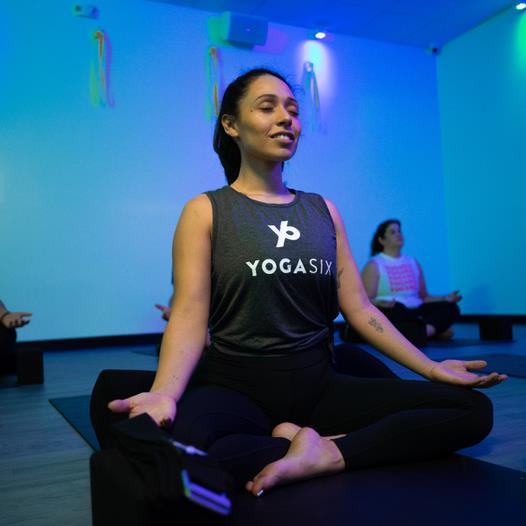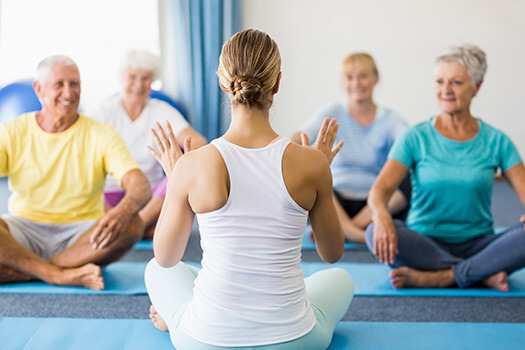
Chronic pain is a complex and often debilitating condition that affects millions of individuals worldwide. In search of relief, many turn to alternative therapies such as yoga.
This article explores the top 9 yoga practices specifically tailored for various chronic pain conditions, including fibromyalgia, arthritis, migraines, lower back pain, neck pain, sciatica, menstrual pain, pelvic pain, and neuropathic pain.
By combining empathy, knowledge, and a holistic approach, we aim to provide valuable insights and guidance to those seeking freedom from their chronic pain.
Fibromyalgia
Fibromyalgia sufferers can find relief and improved quality of life through the practice of yoga. Yoga poses and meditation techniques can help alleviate the chronic pain, fatigue, and emotional distress associated with this condition. Yoga offers a holistic approach to managing fibromyalgia, addressing not only the physical symptoms but also the mental and emotional aspects.
Certain yoga poses, such as gentle stretches and restorative postures, can help release tension, reduce muscle stiffness, and improve flexibility. These poses promote relaxation and enhance blood circulation, providing much-needed relief to fibromyalgia sufferers. Additionally, meditation techniques incorporated into yoga practice can help calm the mind, reduce stress, and promote a sense of inner peace.
By regularly practicing yoga, individuals with fibromyalgia can experience increased body awareness, improved sleep quality, and enhanced overall well-being. It is important to work with a qualified yoga instructor who understands the specific needs and limitations of fibromyalgia patients, ensuring a safe and effective practice.
Embracing yoga as part of a holistic treatment plan can empower fibromyalgia sufferers to reclaim their freedom and live a fulfilling life.

Arthritis
For individuals with arthritis, incorporating yoga into their routine can provide numerous benefits for managing chronic pain and improving overall well-being.
Arthritis is a chronic condition that affects the joints, causing pain, stiffness, and reduced mobility. Yoga, with its gentle movements and focus on breath control, can help alleviate these symptoms and promote arthritis management.
The practice of yoga for arthritis involves poses that increase flexibility, strengthen muscles, and improve balance. These poses can help reduce joint pain and inflammation, increase joint mobility, and enhance overall joint function.
Additionally, yoga can also help individuals with arthritis manage stress and anxiety, which are often associated with chronic pain conditions.
Migraines
Yoga practices can be beneficial in managing migraines and reducing their frequency and intensity. When it comes to migraines, finding relief is of utmost importance.
Yoga poses for migraine relief can help calm the mind, release tension, and alleviate pain. One such pose is the Child's Pose, which promotes relaxation and gentle stretching of the spine. Another pose that can provide relief is the Legs-Up-the-Wall pose, which allows blood to flow to the brain, relieving congestion and reducing the intensity of a migraine.
The benefits of yoga for migraines extend beyond the physical. By incorporating deep breathing exercises and mindfulness techniques, yoga helps to reduce stress, which is often a trigger for migraines.

Lower Back Pain
Managing chronic lower back pain can be aided by incorporating specific yoga practices into your routine.
Lower back pain is a common condition that can greatly impact our daily lives, making it difficult to perform simple tasks or enjoy our favorite activities. However, with the right approach, it is possible to find relief and regain freedom from pain.
Yoga poses can provide an effective means of pain management for lower back pain. Certain poses, such as Cat-Cow, Child's Pose, and Bridge Pose, can help stretch and strengthen the muscles in the lower back, promoting flexibility and reducing discomfort.
Taking a holistic approach to lower back pain through yoga can not only alleviate physical tension but also contribute to mental and emotional well-being.
Neck Pain
Neck pain can be a debilitating condition that affects our daily lives.
Fortunately, there are specific yoga practices that can provide relief and promote healing.
Corrective neck stretches, strengthening shoulder exercises, and relaxation techniques are key points to address in order to alleviate neck pain and restore balance to the body.

Corrective Neck Stretches
To alleviate neck pain, incorporating corrective stretches into your daily routine can be highly beneficial. These stretches can help improve neck mobility and release tension, allowing you to experience greater freedom and relief from discomfort.
Here are four corrective neck stretches that you can try:
- Neck tilts: Gently tilt your head to the right, bringing your right ear towards your right shoulder. Hold for a few seconds, then repeat on the left side.
- Neck rotations: Slowly rotate your head to the right, moving it in a circular motion. Repeat in the opposite direction.
- Chin tucks: Start with your head in a neutral position, then gently tuck your chin towards your chest. Hold for a few seconds before releasing.
- Shoulder rolls: Roll your shoulders forward and backward in a circular motion, allowing the movement to extend to your neck.
Incorporating these corrective neck stretches into your daily routine can help improve neck mobility, release tension, and provide relief from chronic neck pain.
Strengthening Shoulder Exercises
To address neck pain and improve overall neck mobility, incorporating strengthening shoulder exercises into your routine is essential. Neck pain is often caused by poor posture, muscle imbalances, and lack of shoulder mobility and stability. By focusing on strengthening the shoulders, you can alleviate tension in the neck and promote proper alignment.
One effective shoulder exercise for neck pain is the shoulder blade squeeze. Start by sitting or standing with your arms relaxed at your sides. Gently squeeze your shoulder blades together, feeling a stretch across your chest. Hold the squeeze for a few seconds, then release. Repeat this exercise several times throughout the day to improve shoulder mobility and stability.
Another beneficial exercise is the overhead press. Begin by standing with your feet hip-width apart and holding a dumbbell in each hand. Raise your arms to shoulder level, then press the weights overhead, fully extending your arms. Lower the weights back down to shoulder level and repeat. This exercise strengthens the muscles in your shoulders and improves shoulder stability.
Incorporating these shoulder exercises into your routine can help alleviate neck pain and improve shoulder mobility and stability. Remember to start with light weights and gradually increase as you gain strength. Always listen to your body and consult with a healthcare professional if you have any concerns or underlying conditions.

Freedom from neck pain is within reach, and these exercises can help you achieve it.
Relaxation Techniques for Relief
Incorporating relaxation techniques can provide relief for individuals experiencing neck pain. When it comes to finding relief from the discomfort and tension in the neck, deep breathing exercises and guided imagery techniques can be incredibly beneficial. These techniques not only help to relax the muscles in the neck but also promote a sense of calm and overall well-being.
Here are four relaxation techniques that can offer relief for neck pain:
- Deep breathing exercises: Take slow, deep breaths, focusing on expanding your belly as you inhale and releasing tension as you exhale. This helps to release tension in the neck and promotes relaxation.
- Guided imagery techniques: Visualize yourself in a peaceful, serene environment, such as a beach or a forest. Imagine the tension in your neck melting away as you immerse yourself in this calming imagery.
- Progressive muscle relaxation: Starting from your toes and working your way up to your neck and head, systematically tense and then relax each muscle group. This technique helps to release tension and promote relaxation in the neck.
- Mindfulness meditation: Focus your attention on the present moment, non-judgmentally. Paying attention to your breath and the sensations in your body can help to alleviate neck pain and promote relaxation.
Sciatica
Yoga poses can alleviate the symptoms of sciatica, a condition characterized by radiating pain along the sciatic nerve. Sciatica can cause discomfort, numbness, and weakness in the lower back, buttocks, and legs. Fortunately, yoga offers a holistic approach to managing this condition.
Several yoga poses can provide relief from sciatic nerve pain. Poses such as the Reclining Hand-to-Big-Toe pose, the Supine Pigeon pose, and the Bridge pose can help stretch and strengthen the affected areas, reducing pain and promoting healing. Additionally, incorporating gentle stretches and exercises into a regular yoga practice can help improve flexibility and reduce inflammation.
Yoga for sciatica is not just about physical postures; it is also about connecting with the breath and cultivating a sense of mindfulness. By practicing yoga, individuals with sciatica can find freedom from pain and discomfort, both physically and mentally. Remember to listen to your body, modify poses as needed, and seek guidance from a qualified yoga instructor to ensure safe and effective practice.
Menstrual Pain
Yoga poses can alleviate the symptoms of menstrual pain, providing relief and promoting well-being. Menstrual cramps can be debilitating, but incorporating specific yoga poses into your routine can help ease the discomfort and bring a sense of freedom during your menstrual cycle.

Here are four yoga poses for menstrual pain relief:
- Child's Pose (Balasana): This gentle pose helps to relax the pelvic muscles and relieve tension in the lower back, providing relief from menstrual cramps.
- Supine Twist (Supta Matsyendrasana): This pose helps to release tension in the lower back and abdomen, reducing menstrual pain and discomfort.
- Cat-Cow Pose (Marjaryasana-Bitilasana): This gentle flow between cat and cow poses helps to stretch and relax the lower back, relieving menstrual cramps.
- Bridge Pose (Setu Bandhasana): This pose strengthens the pelvic muscles and improves blood flow to the reproductive organs, reducing menstrual pain.
Pelvic Pain
For individuals experiencing pelvic pain, implementing targeted yoga practices can provide relief and support in managing this chronic condition.
Pelvic pain can be caused by a variety of factors, including muscle tension, inflammation, or nerve sensitization. Yoga poses that focus on stretching and strengthening the pelvic region can help alleviate pain and improve overall well-being.
Some beneficial yoga poses for pelvic pain include the butterfly pose, child's pose, and reclining bound angle pose. These poses help release tension in the pelvic area, improve blood flow, and promote relaxation.
Additionally, pelvic floor exercises, such as kegels, can be incorporated into a yoga practice to strengthen the muscles that support the pelvic organs.
Neuropathic Pain
One effective approach for managing neuropathic pain is through targeted yoga practices. Yoga for nerve pain and yoga for nerve damage can help alleviate symptoms and improve overall well-being.
Here are four yoga practices that can be beneficial for individuals experiencing neuropathic pain:

- Gentle stretching: Incorporating gentle stretches into your yoga routine can help increase flexibility and reduce muscle tension, which can alleviate nerve pain.
- Breathing exercises: Deep breathing techniques can promote relaxation and reduce stress, which is essential for managing neuropathic pain.
- Meditation: Practicing mindfulness meditation can help shift your focus away from the pain and promote a sense of calm and inner peace.
- Restorative poses: Restorative yoga poses, such as supported child's pose or legs up the wall, can provide deep relaxation and promote healing in the nervous system.
Frequently Asked Questions
Can Yoga Completely Cure Chronic Pain Conditions Like Fibromyalgia or Arthritis?
While yoga can be a valuable complementary therapy for chronic pain conditions such as fibromyalgia or arthritis, it may not completely cure them. However, the practice's emphasis on mindfulness can help manage symptoms and improve overall well-being.
What Are the Potential Risks or Side Effects of Practicing Yoga for Chronic Pain?
Potential risks and side effects of practicing yoga for chronic pain include exacerbation of pain, muscle strains, and joint injuries. It is important to approach yoga with caution, seek guidance from a qualified instructor, and listen to your body's limits to minimize these risks.
How Long Does It Typically Take for Yoga to Start Alleviating Chronic Pain Symptoms?
The time it takes for yoga to alleviate chronic pain symptoms varies depending on the individual and the specific condition. However, yoga can be a long-term solution for chronic pain, providing relief and improving overall well-being.
Can Yoga Worsen Certain Chronic Pain Conditions, Such as Migraines or Sciatica?
Yoga has the potential to worsen certain chronic pain conditions, such as migraines or sciatica, depending on the individual and their specific condition. It is important to practice under the guidance of a knowledgeable instructor and adapt poses to avoid exacerbating symptoms.
Are There Any Specific Yoga Poses or Practices That Should Be Avoided for Individuals With Chronic Pain?
When practicing yoga with specific chronic pain conditions, it is important to be mindful of certain poses or practices that may exacerbate discomfort. Identifying and avoiding these poses can help individuals find relief and prevent further injury.
 Business & FinanceHealth & MedicineTechnologyLifestyle & CultureScience & EnvironmentWorld NewsPrivacy PolicyTerms And Conditions
Business & FinanceHealth & MedicineTechnologyLifestyle & CultureScience & EnvironmentWorld NewsPrivacy PolicyTerms And Conditions
